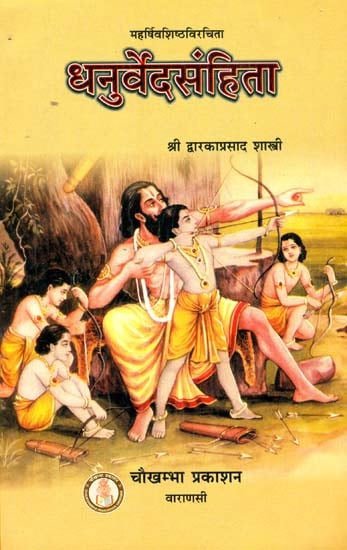Dhanurveda Samhita [sanskrit]
3,015 words
The Sanskrit text of the Dhanurveda-samhita attributed to Vasishtha. Dhanur Veda is a type of ancient India science whose roots date to the 2nd millenium BCE. It is counted among the Upavedas literature. This specific version of the Dhanurveda contains roughly 240 sections of Sanskrit text.
Verse 1.92
अथ धनुर्व्यायाः ।
कैशिकः केशमूले वै शरः शृङ्गे च सात्त्विकः ।
श्रवणे वत्सकर्णश्च ग्रीवायां भरतो भवेत् ॥ ९२ ॥
atha dhanurvyāyāḥ |
kaiśikaḥ keśamūle vai śaraḥ śṛṅge ca sāttvikaḥ |
śravaṇe vatsakarṇaśca grīvāyāṃ bharato bhavet || 92 ||
Note! The following is not a translation of the above verse, but merely an arbitrary extract of the English text.
Then the bow exercises. The Kaishika is the arrow at the root of the hair, and the Sattvic is the arrow at the horn. The ears of a calf should be placed on the ears, and the ears of a calf should be placed on the neck.
English translation by Hardayalu Swami (2001) Buy now!
Glossary of Sanskrit terms
Note: This extracts Sanskrit terms and links to English definitions from the glossary, based on an experimental segmentation of verse (1.92). Some terms could be superfluous while some might not be mentioned. Click on the word to show English definitions.
Atha, Dhanu, Dhanus, Vyaya, Kaishika, Kesha, Mula, Shara, Sharas, Shringa, Shringi, Sattvika, Shravana, Vatsaka, Rina, Griva, Bharat, Bharata,
Analysis of Sanskrit grammar
Note: this is an experimental feature and only shows the first possible analysis of the Sanskrit text (Verse 1.92). If the system was successful in segmenting the sentence, you will see of which words it is made up of, generally consisting of Nouns, Pronouns, Verbs, Participles and Indeclinables. Click on the link to show all possible derivations of the word.
- Line 1: “atha dhanurvyāyāḥ ”
- atha -
-
atha (indeclinable)[indeclinable]
- dhanur -
-
dhanus (noun, neuter)[compound], [adverb], [nominative single], [vocative single], [accusative single]dhanu (noun, feminine)[nominative single]dhanu (noun, masculine)[nominative single]
- vyāyāḥ -
-
vyāya (noun, masculine)[nominative plural], [vocative plural]
- Line 2: “kaiśikaḥ keśamūle vai śaraḥ śṛṅge ca sāttvikaḥ ”
- kaiśikaḥ -
-
kaiśika (noun, masculine)[nominative single]
- keśa -
-
keśa (noun, masculine)[compound], [vocative single]keśa (noun, neuter)[compound], [vocative single]
- mūle -
-
mūla (noun, masculine)[locative single]mūla (noun, neuter)[nominative dual], [vocative dual], [accusative dual], [locative single]mūlā (noun, feminine)[nominative dual], [vocative single], [vocative dual], [accusative dual]√mūl (verb class 1)[present middle first single]
- vai -
-
√vā (verb class 1)[present middle first single], [imperative middle first single]
- śaraḥ -
-
śaras (noun, neuter)[compound], [nominative single], [vocative single], [accusative single]śara (noun, masculine)[nominative single]
- śṛṅge -
-
śṛṅga (noun, masculine)[locative single]śṛṅga (noun, neuter)[nominative dual], [vocative dual], [accusative dual], [locative single]śṛṅgi (noun, feminine)[vocative single]
- ca -
-
ca (indeclinable conjunction)[indeclinable conjunction]ca (noun, masculine)[compound], [vocative single]ca (noun, neuter)[compound], [vocative single]
- sāttvikaḥ -
-
sāttvika (noun, masculine)[nominative single]
- Line 3: “śravaṇe vatsakarṇaśca grīvāyāṃ bharato bhavet ”
- śravaṇe -
-
śravaṇā (noun, feminine)[nominative dual], [vocative single], [vocative dual], [accusative dual]śravaṇa (noun, masculine)[locative single]śravaṇa (noun, neuter)[nominative dual], [vocative dual], [accusative dual], [locative single]
- vatsakar -
-
vatsaka (noun, masculine)[compound], [vocative single]vatsaka (noun, neuter)[compound], [vocative single]
- ṛṇaś -
-
ṛṇa (noun, masculine)[nominative single]
- ca -
-
ca (indeclinable conjunction)[indeclinable conjunction]ca (noun, masculine)[compound], [vocative single]ca (noun, neuter)[compound], [vocative single]
- grīvāyām -
-
grīvā (noun, feminine)[locative single]
- bharato* -
-
bharat (noun, masculine)[accusative plural], [ablative single], [genitive single]bharat (noun, neuter)[ablative single], [genitive single]bharata (noun, masculine)[nominative single]√bhṛ (verb class 1)[present active third dual]
- bhavet -
-
√bhū (verb class 1)[optative active third single]
Other editions:
Also see the following editions of the Sanskrit text or (alternative) English translations of the Verse 1.92
Dhanurveda Samhita (धनुर्वेदसंहिता)
by Hardayalu Swami (2001)
Publisher: Khemraj Shrikrishnadass
Buy now!
Vasistha’s Dhanurveda Samhita
by Purnima Ray (2023)
Publisher: Khemraj Shrikrishnadas; ISBN-10: 818670289X; ISBN-13: 9788186702895; 88 pages including 18 illustrations;
Buy now!
Dhanurveda Samhita (धनुर्वेदसंहिता) (संस्कृत एवं हिंदी अनुवाद)
by Shri Dwarka Prasad Shastri (2007)
Title: Dhanurveda Sanhita (Hindi translation); Publisher: Chaukhambha Prakashan, Varanasi; 84 pages including 11 illustrations; Author: महर्षि वशिष्ठ (Maharshi Vashistha); Foreword by Dr. Chakradhar Bijalwan.
Buy now!![Dhanurveda Samhita [sanskrit] - book cover](/uploads/a/Dhanurveda-Sanskrit.jpg)

